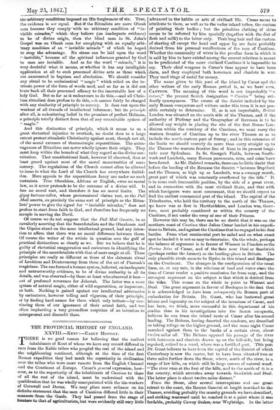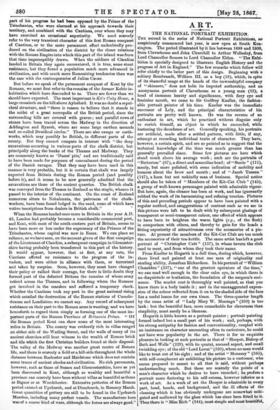THE PROVINCIAL HISTORY OF ENGLAND.
XXVIH.—KENT :—.EARLY Hisronv.
TVHERE is no good reason for believing that the earliest
inhabitants of Kent of whom we have any record differed in race from the Keltic tribes who peopled the rest of the island and the neighbouring continent, although at the time of the first Roman expedition they had much the superiority in civilization over the tribes who were more remote from the English Channel and the Continent of Europe. Csesar's general expression, how- ever, as to the superiority of the inhabitants of Cantium to the of all the rest of the island, must be understood with the qualification that he was wholly-unacquainted with the tin-workers of Cornwall and Devon. We may place more reliance on his -definite statement that the .131en of Cana= differed little in their manners -from the Omits. They had passed from the stage of banters to that of agriculturists, but were evidently still very little
advanced in thelabits or arTs of ebtllized life. Ciesar seems to +attribute to them, as well ante the ruder inlaudtribes, the custom of painting 'their bodies ; but the primitive clothing of skins teems to be referred by him specially (together with the-diet of flesh and milk) to the latter only. Their long hair and the custom of shaving all except the head and upper lip are facts probably derived 'from his personal recollections of the men of Centime. 'Whether the community of wives in the peculiar form in which it is said by him to have existed among the nearest relatives is meant to be predicated of the more civilized'Cantiaus it is impossible to ,say. Their chief weapons in Gasser's time appear to 'have been 'darts, and they employed both 'horsemen and chariots in war. They used' rings of metal for money.
The name given 'to this part of the island by Caner and the other writers of the early Roman -period is, as we have seen, Csaeriust. The meaning of this word is not improbably " a corner," the present Scotch designation " Cantire" 'being evi- dently synonymous. The extent of the district includedby the -early Roman conquerors and writers under this term it is not pos- sible certainly to determine. If, as is not improbable, British London was situated on the south side of the Thames, and if the authority of Ptolemy and the Geographer of Ravenna is to be allowed any weight in placing the site of the first Roman %Lon- dinium within the territory of 'the Cantians, we must carry the western frontier of Cantium up to the river Thames so as to include the north-eastern part of Surrey ; and-in this extension of the limits we should scarcely do more than carry straight up to the Thames the western frontier line of Kent in its present-longi- tude near Sydenham. In St. George's Fields, between South- wark and Lambeth, many Roman pavements, urns, and coins-have been found. As Mr. Halsted remarks, there can be little doubt 'that before the landing of the Romansthe district "between 'Deptford and the Thames, as high up as Isunbeth, was a swampy marsh, great part of which was constantly overflowed by the tide." It is in some such inaccessible position, by the side of a great river, and in connection with the most civilized State, and that with which foreigners were most conversant, that we shoeld expect to find the earliest commercial port of .the island. The capital of the Tiinobantes, who held the.territory to the north of the Thames, sye know was at first in Hertfordshire, and -London was,- there- fore, most probably considered as within the country of the Gentians, if not under the sway of one of their Princes.
However this may be, there can- be no doubt that it was fon the southern coast of Ccuitium that Julius Cassar landed in bis,expedi- tious to Britain, and against the Cantians that he engaged in his first battles. From what continental port he sailed and on what exact spot he lauded it is not so easy to determine. On the whole, perhaps the balance of argument is in favour of Wissant in Flanders as the Portus Ieitts of Ctesar, and 'of the flats near Deal or Sandwich (perhaps rather the former) as the landing-place in Britain. The only plausible rivals seem to be Hythe in this island and Boulogne on the Continent. The changes in the configurations:if the-coast lines, or, at any rate, in the relations of land and water since the time of Cmsar render a positive conclusion far from easy, sand the strongest argument on the subject is that which is derived from the tides. This seems on the whole to point to Wissant and Deal. The great argument in favour of Boulogne is the fact that it is acknowledged to have been subsequently the Roman port of embarkation for Britain. Dr. Guest, who has bestowed great labour and ingenuity on the subject of the invasions of Caesar, and has been, we think, more successful in this department of his studies than in his investigations into the Saxon conquests, believes he can trace the inland route of Cmsar after his second landing. The Britons, having deserted the seashore, are described as taking refuge on the higher ground, and the same night Caisar marched against them to the banks of a certain river, about twelve milesi off. The Britons opposed his passage of the river with horsemen and chariots drawn up on the hill-side, but being repulsed, retired to a wood, where was a fortified post. This post Dr. Guest believes to have been the capital of the district of which Canterbury is now the centre, but to have been situatedlwo or three miles farther down the Stour, where, north of the river, is a range of low hills, on which still lie large masses of natural wood. "The river runs at the foot of the hills, and to the south of it is a flat country, which stretches away towards Sandwich and Deal. The latter place is about twelve milea distant."
From the Stour, after eeveral interruptions and one great retreat to the coast, the Roman General at length marched to the Thames, avoiding probably the marshy grounds we have described, and striking westward until he reached it at a point where it was fordable, probably Coway Stakes,,near Weybridge. In the latter part of his progress he had been opposed by the Prince of the Teinobantes, who were alarmed at his approach towards their territory, and combined with the Cantians, over whom they may have exercised an occasional superiority. We need scarcely refer to the very transient character of this first Roman conquest of Cantiam, or to the more permanent effect undoubtedly pro- duced on the civilization of the district by the closer relations with the Roman Empire into which this part of the island was from that time imperceptibly drawn. When the soldiers of Claudius landed in Britain they again encountered, it is true, some stout resistance, but they found a population much more advanced in civilization, and with much more Romanizing tendencies than was the case with the contemporaries of Julius Caesar.
But before we speak of the permanent conquest of Kent by the Romans, we must first refer to the remains of the former Keltie in- habitation which have descended to us. There are fewer than we should have expected. The most important is Kit's Cagy House, a large cromlech on the hill above Aylesford. It was no doubt a sepul- chral structure, and "there is reason to believe that it stands in the midst of a great necropolis of the British period, since the surrounding hills are covered with graves ; and parallel rows of stones have been traced across the Medway in the direction of Addington and Ryarsh, where are some large earthen mounds and so-called Druidical circles." There are also camps or earth- works, which may possibly be British, in different parts of the county. But they cannot compare in interest with "the deep excavations occurring in various parts of the chalk district, but principally along the banks of the Thames and Medway. They are commonly known as 'Danes' pits,' and are traditionally said to have been made for purposes of concealment during the period of the Danish ravages. That they may have been used in this manner is very probable, but it is certain that chalk was largely exported from Britain during the Roman period (and possibly before it), and it seems to be now generally admitted that the excavations are those of the ancient quarries. The British chalk was conveyed from the Thames to Zealand as the staple, whence it passed to the interior of the continent. On the coast of Zealand numerous altars to Nehalennia, the patroness of the chalk- workers, have been found lodged in the sand, some of which have votive inscriptions from dealers in British chalk."
When the Romanis landed once more in Britain in the year A.D. 43, London had probably become a considerable commercial port, and Kent, with most of the south-eastern part of Britain, seems to have been more or less under the supremacy of the Princes of the Trinobantes, whose capital was now in Essex. We can place no reliance, as we have seen, on the account given of the first campaign of the Lieutenant of Claudius, a subsequent campaign in Gloucester- shire having probably been transferred to this part of the history. It would appear, however, that at first, at any rate, the Cantians offered no resistance to the progress of the in- vaders, and were either in alliance with them, or terrorized and taken by surprise. Soon, however, they must have changed their policy or rallied their courage, for there is little doubt they formed part of the defeated Britons the remains of whose army retired across the Thames, and in following whom the Romans got involved in the marshes and suffered a temporary check. Whether the Cantians took any part in the great national rising which entailed the destruction of the Roman stations of Camelo- dunum and Londinium we cannot say. Any record of subsequent resistance on their part to the Roman arms is wanting,- and we have henceforth to regard them simply as forming one of the most ina- portant parts of the Roman Province of Britannia Prima. "Of the Roman period Kent can show some of the most interesting relics in Britain. The county was evidently rich in villas ranged on either side of the Watling Street, and the walls of many of its ancient churches still bear witness to the wealth of Roman brick and tile which the first Christian builders found at their disposal. The valley of the Medway was another great centre of Roman life, and there is scarcely a field or a hill-side throughout the whole distance between Rochester and Maidstone which does not contain
some traces of ancient abodes and civilization. No rich pavements, however, such as those of Sussex and Gloucestershire, have as yet been discovered in Kent, although so wealthy and beautiful a province can scarcely have been without villas as beautiful as those at Bignor or at Woodchester. Extensive potteries of the Roman • period existed at Upchurch, and at Dimchurch, in Romney Marsh. Great quantities of pottery are still to be found in the Upchurch Marshes, including many perfect vessels. The manufacture here was of a coarse kind of ware, although the forms are always good."































 Previous page
Previous page